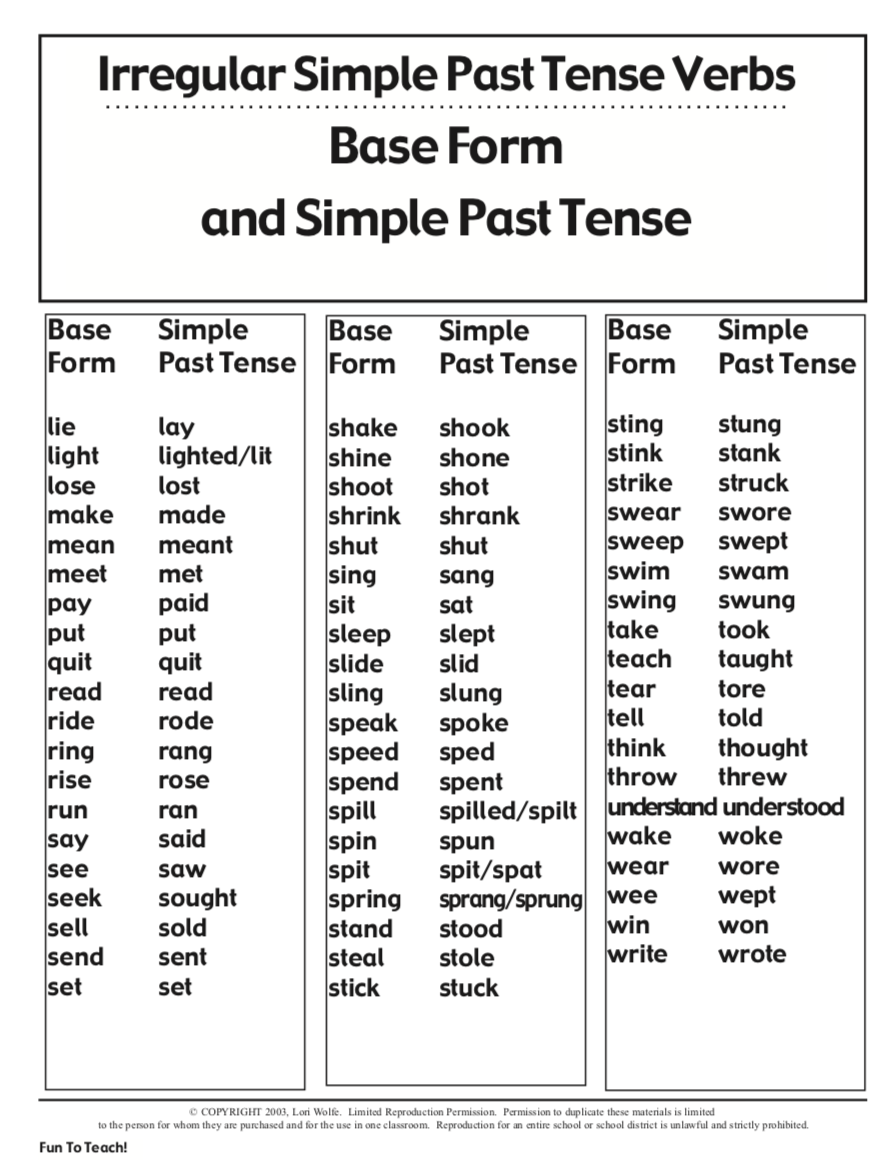
Instead of listing the irregular verbs in each of their verb tenses, we only mention the simple past tense and past participle forms, along with the base. Want a list of irregular verbs in the English language? Below we list the common irregular verbs to help you study and provide a quick-reference resource in case you forget one later (note that the past tense verbs in the chart below are shown in American English forms there are some differences in British English ).
#Irregular past tense of ring full
You can find a full list of irregular verbs that don’t change below. Likewise, irregular verbs that don’t change at all, like “bet” or “spread,” are also weak. One of the most common examples of an irregular weak verb is “sleep”: BaseĪlthough “sleep” has its own special past tense and past participle forms (“slept”), it still keeps e as the main vowel, making it a weak verb. The confusion comes with weak verbs, because some weak verbs are irregular, too. With these rules in mind, we can see that all strong verbs are irregular. Weak verbs, on the other hand, keep their vowel the same in the past tense, like the a in dance. Strong verbs are any verb that changes its vowels in the past tense, like how the i in “sing” changes to an a for the past tense. Irregular verbs and regular verbs are often confused with strong verbs and weak verbs, although they are very similar. Like “be,” quite a few other linking verbs are irregular as well, such as “become” and “feel.” Also, irregular verbs can be either transitive or intransitive verbs and can still be used as imperative verbs.

Be aware that certain exceptions, like the verb “be,” have special present tense forms as well. This includes adding an “-s” or “-es” for the third-person singular. The simple present tense is conjugated the same no matter whether the verb is regular or irregular. I have sung opera before, but I have never danced to it. In practice, you end with conjugations like these:
#Irregular past tense of ring how to
The only way to know how to conjugate “sing” is to memorize its special forms. Instead, “sing” has both a unique past tense and also a unique past participle form. You can’t use “singed” because that’s an incorrect form for this verb. “Sing,” however, is irregular, so the normal rules don’t work. To create both the simple past tense and past participle forms, you simply add “-ed,” or in this case only “-d” because the base form ends in e already. To conjugate “dance,” there’s no big surprise or trick you just use the same formula as with most other verbs. To show you what we mean, let’s “dance” and “sing!” This pair is a good example to see the differences: “dance” is a regular verb, but “sing” is an irregular verb. (Just a reminder: The past participle is the form used with the present perfect tense. Irregular verbs, however, use completely original words for their different verb forms when they’re the main verb of a sentence. You could say irregular verbs are verbs that “follow their own rules.” Regular verbs follow the standard grammar rules of modern English in adding “-ed” or “-d” to form the past tense and past participle forms. – modifying nouns: You can spend the enclosed money on whatever you likeįor this reason, the past participle form is also referred to as verb 3, and that’s what we use in the table below.To help you with this, below we list the common irregular verbs and their tense forms, along with a quick explanation of what they are and how they work. – forming the passive voice: 1000 widgets are produced in the factory every day – forming the perfect aspect: I have already eaten / He had arrived The past participle form also has different functions, for example: Referring to it as the “past tense form” can therefore cause confusion, and in the table below we refer to it as verb 2. This is because it also has other functions, such as in unreal conditionals and to talk about wishes in the present. The past tense form (so-called because of its use with this tense) is also referred to as verb 2.

Here’s a list of some of the more common irregular verbs. What are some common irregular verbs in English? Irregular verbs are formed differently, for example: Base form Regular verbs do follow this pattern, for example: Base form An irregular verb is one which does not follow the normal pattern of “base form + ed” in the past tense form and past participle form.


 0 kommentar(er)
0 kommentar(er)
